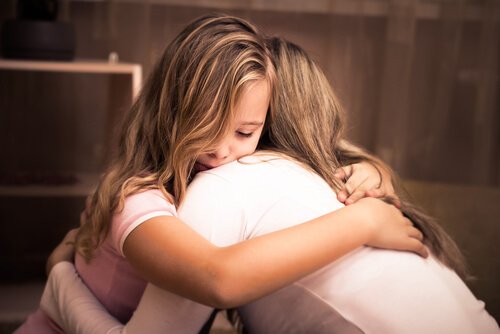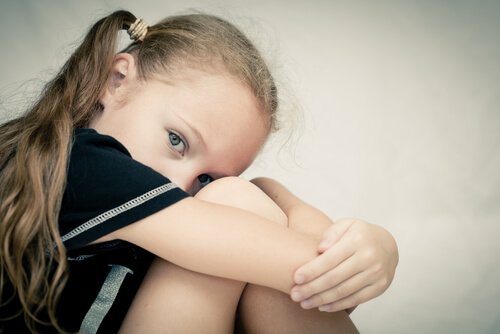Family Wounds Take the Longest to Heal

It’s pretty difficult to find a family that can live together without having problems. Even though there can be great love, understanding and respect, each member is different and unique. This can generate problems in coexistence that can end up causing family wounds.
These wounds can significantly affect the lives and hearts of each person that is part of the nuclear family. They can also leave emotional aftermath.
How to heal family wounds
Despite the fact that emotional wounds are the deepest, it’s necessary to try to restore those bonds that keep the family united. You can do this through a series of steps that will help you heal internally in a fast and effective way.

1. Accepting that healing cannot be instantaneous
Every external wound takes time to heal, and the same thing happens when it comes to feelings. Because of this, you can’t assume attitudes or behaviors against this rule.
2. Correcting everything that is necessary
If someone has done something that has offended and affected the family, it’s important to offer a sincere apology and make an effort to fix things. This way, those who are part of the family will see that there is remorse and the situation can move forward.
3. Forgiveness
When a problem exists, it’s necessary to learn how to forgive. This is true especially when the person tries to change his or her behavior. To help, the rest of the family should support this step.
4. Focusing on the present
When they recover from family wounds, people tend to direct all their attention to the problems that lead to feeling upset with their family. Nevertheless, in order to heal, it’s important to stop living in the past. You must forget the things that only prevent you from moving forward.
5. Seeking healing
When you’re in the process of change, mistakes and stumbles will always arise. That’s why it’s necessary to try to construct healthier and stronger relationships. You should also try to take note of all the positive changes that have happened up to that moment.
6. Loving each member of the family
Family means the unity of people despite all their shortcomings and setbacks. It’s essential to understand that each person will behave in a different way. Even though love isn’t demonstrated constantly, that doesn’t mean there aren’t feelings of affection towards loved ones.
You have to keep in mind the importance of trying to understand personal feelings both in ourselves and others, which can be expressed in a verbal or physical manner, or through small details. Through empathy, one must learn to recognize others’ feelings, since each person is full of emotions.

7. Encouraging changes
Motivating people who are part of the family environment to practice these changes is the best way to eliminate family wounds. This way, they’ll stop taking things personally and learn how to relieve those problems. It will also increase their self-esteem considerably.
8. Understanding others
When trying to recover a relationship, it’s important to consider the moments that a person has lived and the way in which he/she felt while it was happening. It’s very positive to understand and support while encouraging and forgiving.
Everyone should have the intention of helping and solving problems that cause family wounds. This requires understanding from the people that surround you, and vice-versa. This understanding should be even greater if it relates to your loved ones.
It’s pretty difficult to find a family that can live together without having problems. Even though there can be great love, understanding and respect, each member is different and unique. This can generate problems in coexistence that can end up causing family wounds.
These wounds can significantly affect the lives and hearts of each person that is part of the nuclear family. They can also leave emotional aftermath.
How to heal family wounds
Despite the fact that emotional wounds are the deepest, it’s necessary to try to restore those bonds that keep the family united. You can do this through a series of steps that will help you heal internally in a fast and effective way.

1. Accepting that healing cannot be instantaneous
Every external wound takes time to heal, and the same thing happens when it comes to feelings. Because of this, you can’t assume attitudes or behaviors against this rule.
2. Correcting everything that is necessary
If someone has done something that has offended and affected the family, it’s important to offer a sincere apology and make an effort to fix things. This way, those who are part of the family will see that there is remorse and the situation can move forward.
3. Forgiveness
When a problem exists, it’s necessary to learn how to forgive. This is true especially when the person tries to change his or her behavior. To help, the rest of the family should support this step.
4. Focusing on the present
When they recover from family wounds, people tend to direct all their attention to the problems that lead to feeling upset with their family. Nevertheless, in order to heal, it’s important to stop living in the past. You must forget the things that only prevent you from moving forward.
5. Seeking healing
When you’re in the process of change, mistakes and stumbles will always arise. That’s why it’s necessary to try to construct healthier and stronger relationships. You should also try to take note of all the positive changes that have happened up to that moment.
6. Loving each member of the family
Family means the unity of people despite all their shortcomings and setbacks. It’s essential to understand that each person will behave in a different way. Even though love isn’t demonstrated constantly, that doesn’t mean there aren’t feelings of affection towards loved ones.
You have to keep in mind the importance of trying to understand personal feelings both in ourselves and others, which can be expressed in a verbal or physical manner, or through small details. Through empathy, one must learn to recognize others’ feelings, since each person is full of emotions.

7. Encouraging changes
Motivating people who are part of the family environment to practice these changes is the best way to eliminate family wounds. This way, they’ll stop taking things personally and learn how to relieve those problems. It will also increase their self-esteem considerably.
8. Understanding others
When trying to recover a relationship, it’s important to consider the moments that a person has lived and the way in which he/she felt while it was happening. It’s very positive to understand and support while encouraging and forgiving.
Everyone should have the intention of helping and solving problems that cause family wounds. This requires understanding from the people that surround you, and vice-versa. This understanding should be even greater if it relates to your loved ones.
All cited sources were thoroughly reviewed by our team to ensure their quality, reliability, currency, and validity. The bibliography of this article was considered reliable and of academic or scientific accuracy.
- Bojorge-Martínez, A. E. (2016). Los patrones de comunicación familiar y su impacto en la promoción de la dieta correcta y la activación física en la adolescencia. Tesis de Maestría, Maestría en Comunicación de la Ciencia y la Cultura. Tlaquepaque, Jalisco: ITESO.
- Koerner, A., & Fitzpatrick, M.A. (2002). Toward a Theory of Family Communication. Communication Theory, 12, 70 – 91.
- Tapia, M. (2008). La Comunicación Familiar: Definición, Teorías y Esquemas. Facultad de Filosofía y Letras. Universidad de Navarra. Pamplona: España
- Suarez, O., & Moreno, J. (2002). La familia como eje fundamental en la formación de valores en el niño. Carabobo: Universidad de Carabobo.
This text is provided for informational purposes only and does not replace consultation with a professional. If in doubt, consult your specialist.








